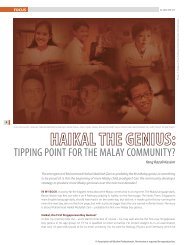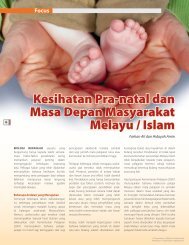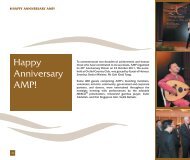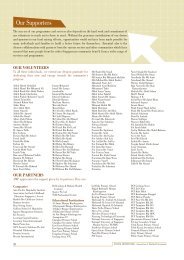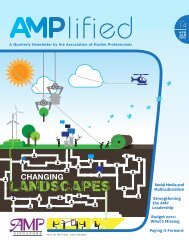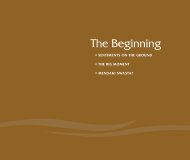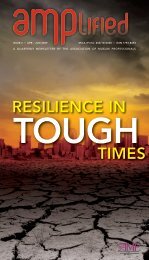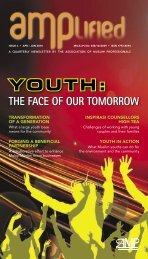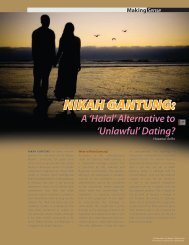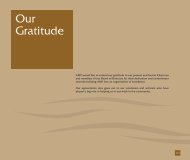SIRAM AND PARAM - Association of Muslim Professionals
SIRAM AND PARAM - Association of Muslim Professionals
SIRAM AND PARAM - Association of Muslim Professionals
Create successful ePaper yourself
Turn your PDF publications into a flip-book with our unique Google optimized e-Paper software.
KARYAWAN<br />
Feeling the Pulse <strong>of</strong> the Community<br />
<strong>SIRAM</strong> <strong>AND</strong> <strong>PARAM</strong><br />
Hidayah Amin<br />
Hidayah Amin, great granddaughter <strong>of</strong> one <strong>of</strong> the earlier<br />
owners <strong>of</strong> Gedung Kuning, recounts how her grandmother<br />
used traditional healing methods to effectively treat her<br />
patients who went to Gedung Kuning regularly to seek<br />
medical treatment.<br />
23<br />
“Kak Timah, kita datang nak siram.”<br />
(Sister Timah, we have come to ask you to pour water).<br />
AS A child growing up in the 1970s, I did not understand<br />
why there were visitors who came to Gedung Kuning,<br />
our home, to ask Nenek (grandma) to siram or pour water<br />
over their hands and legs. These visitors were women,<br />
girls or boys and sometimes men. Nenek would always<br />
encourage them to consult a Western doctor. Some did<br />
but many preferred to siram.<br />
The Practice <strong>of</strong> Siram<br />
I quietly observed Nenek. She brought these visitors to<br />
the open washing area near the toilets. There, she filled<br />
up a big basin <strong>of</strong> water. She then asked for their full name<br />
and the part <strong>of</strong> the body which was injured or fractured.<br />
Nenek then recited some prayers from the Quran and<br />
blew on the surface <strong>of</strong> the water. She scooped the water<br />
with a small pail and poured the water onto the injured<br />
parts thrice. Nenek’s patients would then have to come<br />
for a siram ‘session’ for two consecutive days.<br />
Nenek tried not to have physical contact with the men<br />
she treated. So, Nenek would fill up three water containers<br />
(one for each day) and gave them instructions on how<br />
to siram. Then Nenek gave her patients param (small<br />
flattened balls <strong>of</strong> herbal medicine) which must be mixed<br />
with water until it becomes a paste and applied onto<br />
the injured parts. Among some <strong>of</strong> the ingredients to<br />
make param were cekor or kencor (a local flower known<br />
as ‘resurrection lily’), jintan putih (cumin) and buah pala<br />
(nutmeg). Nenek would grind all the ingredients, mix<br />
them with tepung beras (rice flour) and roll them into<br />
small balls. She would flatten the balls so that their<br />
shapes resemble a fifty-cent coin. She then dried them<br />
under the sun at Gedung Kuning. When the sky turned<br />
dark, I would help Nenek bring the param in.<br />
Nenek’s patients would sometimes <strong>of</strong>fer to pay Nenek<br />
for her services but she always refused. She said she was<br />
ikhlas (sincere) in helping them. They just needed to give<br />
her two items: some asam (tamarind) and some garam<br />
(salt). I remembered asking Wak Lah, my uncle, why<br />
© <strong>Association</strong> <strong>of</strong> <strong>Muslim</strong> Pr<strong>of</strong>essionals<br />
Permission is required for reproduction.
Feeling the Pulse <strong>of</strong> the Community KARYAWAN<br />
Wak Lah said that in Malay culture, those<br />
ingredients signified the hope <strong>of</strong> getting well<br />
being granted (“biar masin permintaan untuk<br />
sembuh”). Furthermore, those ingredients <strong>of</strong>ten<br />
used in Malay cooking were also food items the<br />
poor could afford to buy.<br />
24<br />
she sought those items from them. Wak Lah said that<br />
in Malay culture, those ingredients signified the hope<br />
<strong>of</strong> getting well being granted (“biar masin permintaan<br />
untuk sembuh”). Furthermore, those ingredients <strong>of</strong>ten<br />
used in Malay cooking were also food items the poor<br />
could afford to buy.<br />
The ‘Healing Power’ <strong>of</strong> Siram<br />
Nenek once told me how the neighbours asked her<br />
mother, Hajah Aisah, to cure their child who had high<br />
fever. The helpless Hajah Aisah told them to seek<br />
medical attention at the hospital. But they refused.<br />
Perhaps poverty led them to seek alternative forms <strong>of</strong><br />
treatment or simply because <strong>of</strong> the trust they had in<br />
the Gedung Kuning family. That night, Hajah Aisah gave<br />
the boy some water to drink. She had blessed the water<br />
with recitations from a surah (chapter) from the Quran.<br />
Miraculously, the boy’s fever subsided and the ever<br />
grateful neighbours thanked Hajah Aisah. Her ‘fame’ as a<br />
healer soon spread to the residents <strong>of</strong> Kampung Gelam.<br />
A young colleague who used to live in Kampung Gelam<br />
affectionately talked about how Nenek used to siram<br />
him all the time. Being an avid soccer player, he was<br />
injured on multiple occasions and he would ask Nenek<br />
to heal his broken bones. Of course Nenek always<br />
reminded him to consult the doctor. My brother Hadi<br />
and I were also Nenek’s patients who benefited from<br />
the siram and param treatment. According to Nenek,<br />
the treatment is a form <strong>of</strong> usaha (attempts) to seek cure;<br />
she believed in balancing traditional cure and western<br />
treatment. To emphasise her conviction <strong>of</strong> all forms <strong>of</strong><br />
usaha, Nenek trusted the Western-trained surgeon and<br />
underwent surgery to cure her breast cancer.<br />
Hajah Aisah, Nenek and Emak (Mother) have since passed<br />
on, leaving only Wak Lah who knew the siram method<br />
<strong>of</strong> healing. Wak Lah told me that one must be pure in<br />
thoughts and intention before one can master the skill.<br />
Our family did not pass on this knowledge to others for<br />
fear <strong>of</strong> abuse. Somehow, I am glad they turned away<br />
<strong>of</strong>ferings <strong>of</strong> money (although some patients were very<br />
insistent they accept the money) unlike some medicine<br />
men who pr<strong>of</strong>ited from others’ illnesses.<br />
I can picture sceptics reading this story shake their<br />
heads in disbelief as they ponder on how one could<br />
“cure” an injury which requires an orthopaedist’s<br />
attention. Perhaps the act <strong>of</strong> siram has a psychological<br />
effect on Nenek’s patients. After all, when they<br />
believed that the siram was effective, their faith<br />
could have actually been the healing power. Perhaps<br />
the ingredients <strong>of</strong> the param somewhat reduced<br />
their swelling and pain, and mended some broken<br />
bones in the process. A doctor once commented<br />
that scientifically, certain psychological states such as<br />
contentment and hope release chemical substances<br />
in the body. These substances will assist the body in<br />
battling ineffective agents and produce a general<br />
sense <strong>of</strong> well-being in the patient.<br />
As far-fetched as the siram and param treatment sounds,<br />
Man has yet to discover much <strong>of</strong> the mysteries <strong>of</strong> the<br />
world <strong>of</strong> traditional medicine and <strong>of</strong> silent healers.<br />
Hidayah Amin is the author <strong>of</strong> Gedung Kuning,<br />
Memories <strong>of</strong> a Malay Childhood (‘Siram and Param’ is<br />
one <strong>of</strong> the 29 historical narratives in the book). She is<br />
also a member <strong>of</strong> the Board <strong>of</strong> Directors <strong>of</strong> AMP and<br />
the Board <strong>of</strong> Management <strong>of</strong> Young AMP.<br />
© <strong>Association</strong> <strong>of</strong> <strong>Muslim</strong> Pr<strong>of</strong>essionals<br />
Permission is required for reproduction.



